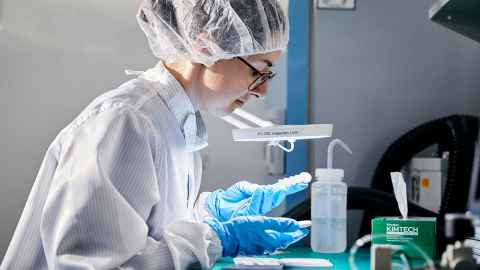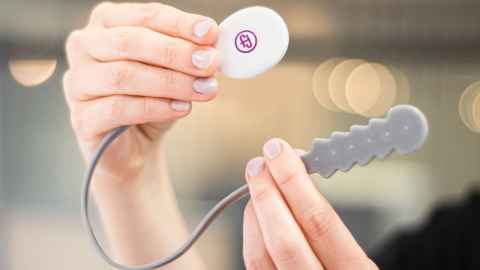Pelvic Floor Group
New technologies and research to help women manage their pelvic floor health.

Our main focus is on pelvic floor muscle function and dysfunction in women. In particular, we are interested in instrumentation development that is able to measure physiological parameters such as pressure, that help inform clinicians, engineers and women themselves of the status of these muscles. These quantitative measurements provide the evidence behind clinical decision making, inform the development of computational models of childbirth, and offer women real-time biofeedback on their pelvic floor health.
Instrumentation development to date
- The elastometer
- Measuring intra-abdominal pressure
- Measuring the vaginal pressure profile
- Helping clinicians with their digital assessment skills
- Quantifying muscle stress during childbirth
Current Research projects
femfit® by JUNOFEM
We have designed and developed a novel intra-vaginal pressure sensor array (femfit®).This can accurately measure the pressure profile along the length of the vagina and provides real time feedback on these pressures via Bluetooth. Information is displayed via an app on a smart device. Currently used in several clinical studies and now on a path to commercialisation by JUNOFEM.
News: JUNOFEM is the Judges Winner in Emerging Health Tech Innovators

Current clinical studies:
- International clinical studies with our collaborators in Sheffield (UK) and Montreal (Canada)
- Auckland DHB - Assessing efficacy of the FemFit in women with incontinence.
We work closely with the Implantable Devices Group (IDG) building on the technology platform for sensing changes in physiological pressure.
Current students:
- Laura Pedofsky (PhD candidate) Is investigating further design iterations of the FemFit and investigate other potential applications of this device.
- Hannah Orr (Masters) Looking at the function of the pelvic floor during physical activity, using the FemFit.
Pelvic floor muscle mechanics
Ongoing research using instrumentation developed at the ABI (the elastometer) to measure muscle properties during and after pregnancy. Determining if change in these properties are risk factors for pelvic floor muscle dysfunction. Previous research within the group has developed a geometrically accurate computational model of the pelvic floor muscles and simulation of vaginal delivery.
Current students:
- Melissa Davidson (PhD Candidate) Is exploring the changes in pelvic floor muscle stiffness that occur during pregnancy and post-partum using the elastometer. I am also interested in assessing the digital palpation skills of clinicians – so testing this against a new ‘palpation instrument’ developed at the ABI.
Top publications
- Kruger, J.,Budgett, D. Goodman, J. Bo, K. Can you train the pelvic floor muscles by contracting other related muscles? Neurourol Urodyn, 2019. 38(2): p. 677-683.
- Tian, T. Budgett, S. Smalldridge, J. Assessing exercises recommended for women at risk of pelvic floor disorders using multivariate statistical techniques. Int Urogynecol J, 2018. 29(10): p. 1447-1454.
- Kruger, J.A., et al., Characterizing levator-ani muscle stiffness pre- and post-childbirth in European and Polynesian women in New Zealand: a pilot study. Acta Obstetricia et Gynecologica Scandinavica, 2017. 96(10): p. 1234-1242.
- Cyr, M. Kruger, J. Wong,V. Dumoulin, C. Girard, I. Morin, M. Pelvic floor morphometry and function in women with and without puborectalis avulsion in the early postpartum period. American Journal of Obstetrics and Gynecology, 2017. 216(3): p. 274.e1-274.e8.
- Yan, X., Kruger, J. Nielsen, P. Nash, M. Effects of fetal head shape variation on the second stage of labour. J Biomech, 2015. 48(9): p. 1593-9.
- Tian, T., et al., Is it what you do or the way you do it? Neurourol Urodyn, 2016. 34(4): p. S38-S39.
- Arora, A.S., et al., Clinical evaluation of a high-fidelity wireless intravaginal pressure sensor. Int Urogynecol J, 2015. 26(2): p. 243-9.
- Schell, A., et al., Design and development of a novel intra-vaginal sensor array. Neurourol Urodyn, 2016. 35(4): p. S355-356.
- Cacciari, L., et al., Reliability of Intravaginal Pressure Measurements during Maximal Voluntary Pelvic Floor Muscle Contraction and Valsalva in Lying and Standing Positions. Neurourology and Urodynamics, 2018. 37: p. S269-S270.
- Kruger, J., et al., Can you train the pelvic floor muscles by contracting other related muscles? Neurourol Urodyn, 2019. 38(2): p. 677-683.
Members
Primary contact
Academics
David Budgett
Martyn Nash
Poul Nielsen
Andrew Taberner
Students
Melissa Davidson
Laura Pedofsky
Hannah Orr
Funding partners
- Ministry of Business and Innovation and Employment. Smart Sensors for the Medical Industry
- Health Research Council: Explorer Grant.
International links
- Australia: University of Melbourne, University of Sydney and University of New South Wales
- Canada: University of Montreal and University of Sherbrooke
- Norway: The Norwegian University of Science and Technology and The Norwegian School of Sport Sciences (NIH)
- UK: University of Sheffield